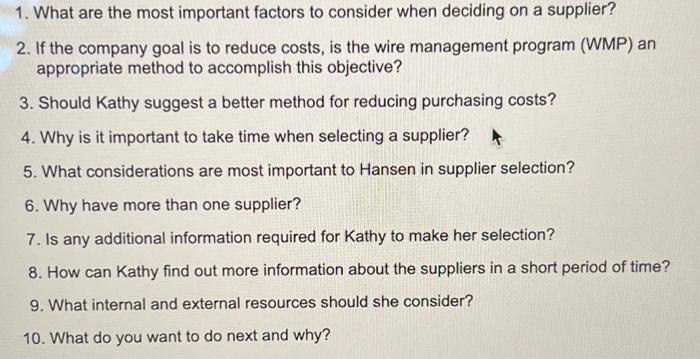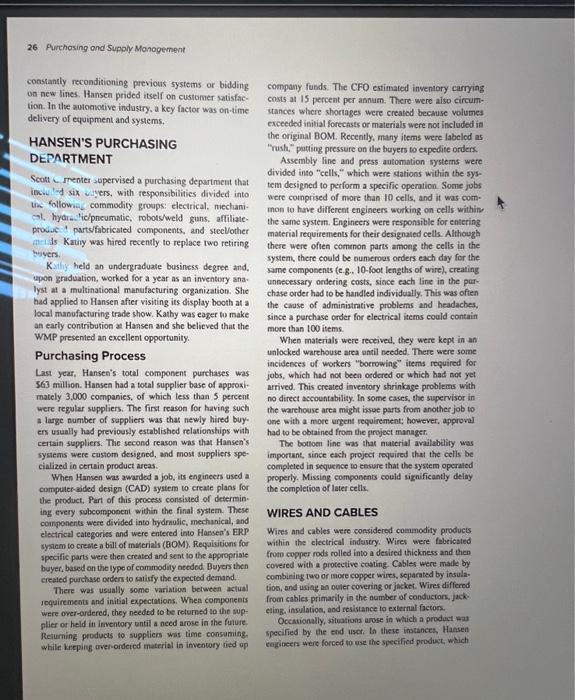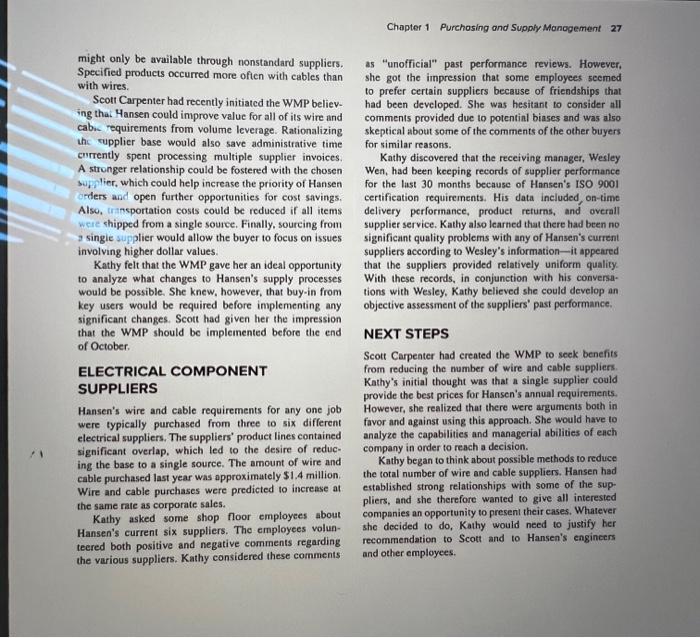1. What are the most important factors to consider when deciding on a supplier? 2. If the company goal is to reduce costs, is the wire management program (WMP) an appropriate method to accomplish this objective? 3. Should Kathy suggest a better method for reducing purchasing costs? 4. Why is it important to take time when selecting a supplier? 5. What considerations are most important to Hansen in supplier selection? 6. Why have more than one supplier? 7. Is any additional information required for Kathy to make her selection? 8. How can Kathy find out more information about the suppliers in a short period of time? 9. What internal and external resources should she consider? 10. What do you want to do next and why? might only be available through nonstandard suppliers. Specified products occurred more often with cables than with wires. Scott Carpenter had recently initiated the WMP believing that Hansen could improve value for all of its wire and cabic requirements from volume leverage. Rationalizing the rupplier base would also save administrative time enrrently spent processing multiple supplier invoices. A stronger relationship could be fostered with the chosen sup, lier, which could help increase the priority of Hansen orders and open further opportunities for cost savings. Also, transportation costs could be reduced if all items were shipped from a single source. Finally, sourcing from 2 singie supplier would allow the buyer to focus on issues involving higher dollar values. Kathy felt that the WMP gave her an ideal opportunity to analyze what changes to Hansen's supply processes would be possible. She knew, however, that buy-in from key users would be required before implementing any significant changes. Scott had given her the impression that the WMP should be implemented before the end of October. ELECTRICAL COMPONENT SUPPLIERS Hansen's wire and cable requirements for any one job were typically purchased from three to six different electrical suppliers. The suppliers' product lines contained significant overlap, which led to the desire of reducing the base to a single source. The amount of wire and cable purchased last year was approximutely $1.4 million. Wire and cable purchases were predicted to increase at the same rate as corporate sales. Kathy asked some shop floor employees about Hansen's current six suppliers. The employees volunteered both positive and negative comments regarding the various suppliers. Kathy considered these comments as "unofficial" past performance reviews. However, she got the impression that some employees seemed to prefer certain suppliers because of friendships that had been developed. She was hesitant to consider all comments provided due to potential biases and was also skeptical about some of the comments of the other buyers for similar reasons. Kathy discovered that the receiving manager, Wesley Wen, had been keeping records of supplier performance for the last 30 months because of Hansen's ISO 9001 certification requirements. His data included, on-time delivery performance, product returns, and overall supplier service. Kathy also learned that there had been no significant quality problems with any of Hansen's current suppliers according to Wesley's information-it appeared that the suppliers provided relatively uniform quality. With these records, in conjunction with his conversations with Wesley, Kathy believed she could develop an objective assessment of the suppliers' past performance. NEXT STEPS Scott Carpenter had ereated the WMP to seck benefits from reducing the number of wire and cable suppliers. Kathy's initial thought was that a single supplier coald provide the best prices for Hansen's annual requirements. However, she realized that there were arguments both in favor and against using this approach. She would have to analyze the capabilities and managerial abilities of each company in order to reach a decision. Kathy began to think about possible methods to reduce the total number of wire and cable suppliers. Hansen had established strong relationships with some of the suppliers, and she therefore wanted to give all interested companies an opportunity to present their cases. Whatever she decided to do, Kathy would need to justify ber recommendation to Scott and to Hansen's engineers and other employees. "We will do it for 10 perecat kess than what you are pay ing right now," Rachel Bonnell. purchasing manapet at Brennan Bank, a large fisancial insutution based in California, had agreed to meet with Scott Kyle, a sales representative from P. folon Ine. (Jolon), a printing sup plici from which Brenifian currently was not buying any. The Scott Kyle's impromptu and unsolicited price quote conceraed the printing and mailing of checks for Brennan. Jrennan, well known for its active promotional effress to attrect consumer deposits, provided standary personalized consumer checks free of charge. Despite the increasing popularity of online banking, the printing of free checks and mailing to customers cost Brennan 510 milfion in the past year. Rachel Bonnell was the purchasing manager in charge of all printing for Brennas and reported directly to the vice president of procurement. It had been Rachel's decision to split the printing and masling of checks equally between two suppliers. During the las five years, both suppliers had provided yuick and quality service, a vital concern of the bank: Aimon all checks were mailed firectly to the eonumers' botne or busines address by the supplien. Because of the importance of check printing. Rachel had requested a special cost analysis study a year ago, with the cooperation of botl. suppliers. The conclusion of this study had been that both suppliers were receiving an adequate proff margie. both were efficieat and cost conscious, and the price structure was fair, Each supplier was on a two-year contract One supplier's contract had been renewed eight moeths age; the other supplier's contract expired in four months. Rachel believed that Scon Kyle was anderbidding to gain part of the check printing business. This, in turn, would give Jolon access to Brennan customer bames and their contact information. Rachel suspected that Jolon migha then try to pursue these cuntorners more actively than the current two suppliers to sell special sceetic checks" and other products that customers paid fos themselves. Case 1-3 Hansen Equipment It was July 2 and Kathy Saxton had just been given her first assignment, the "Wire Management Program" (WMP) by Scott Carpenter, purchasing manager of Atlanta-based Hansen Equipment Inc. The parpose of the WMP was to reduce the supplier base for the company's wire and cable requirements. As a newly bired buyer. Kathy wondered how to proceed. HANSEN EQUIPMENT Hansen Equipment Inc. (Hansen) was a relatively new division of Hansen Eqaipmera International, a malliantional electrical enginecring and techuology company Hansea generated saies of $130 million in the past year and had forecast growth of 25 percent for each of the upeoming four years. Hansen manufactured material handling systems. mainly for customers in the automotive indusiry. Its principal product lines were assembly line equiprnens and press automation equipment. Assembly line products included units such as framers, in which a vehicle frame was fod onto a liae and welded in specified areas. Press automatioe products were units that moved parts-such as velicle frames, doors, and hoods - between large stamping machines as part of the customer's manufaceuring process. Hansen's systems were built in Atlanta. tested, approved, disassembled into sections, shipped to the customer's focility, and then reassembled. All Hansen sysuems were cusoin desizned, based on the unigye reyuirements of the cursoner, including manufacturing equipmen and product characteristics. Kathy estinated that 95 perceis of compoesen orders were job specific. Each Hansen system was composod of steel. mechanieal, electrical, and hydraalic parts. Wires and eables were important ports of these systems. With abitmotive design changes oceurring refularly. Hanken wa constantly reconditioning previous systems or bidding on new lines. Hansea prided itself on customer gatisfaction. In the automotive industry, a key factor was on-time delivery of equipment and systems. HANSEN'S PURCHASING DEPARTMENT Seott L Irenter supervised a purchasing deportment that inw' d six wyers, with responsibilitics divided into uh follownic commodity groups: electrical, mechanicl. hydinstic/pneumatic, robotsweld guns, affiliateproduc A partsfabricated components, and steel/other mrits Katily was hired recently to replace two retiring bisyers. Kathy held an undergraduate business degree and, upon griduation, worked for a year as an inventory sna. lyst at a multinational manefacturing organization. She had applied to Hansen after visiting its display booth at a local manufacturing trade show. Kathy was eager to make an early contribution at Hansen and she believed that the WMP presented an excellent opportunity. Purchasing Process Last year, Hansen's total component purchases was 563 million. Hansea had a total supplier base of approximately 3.000 companies, of which less than 5 percent were regular suppliers. The first reason for having such a large number of suppliers was thas newly hired buy: ers usually had previously establishod relationships with certain suppliers. The second reason was that Hansen's systems were custom designed, and most suppliers specialized in certain product areas. When Hansen was awarded a job, its engineers used a computer-aided design (CAD) system to create plans for the product. Part of this process consisted of determin. ing every subcompooent within the final system. These components were divided into hydraulic, mechanical, and electrical categories and were entered into Hassen's ERP sysuem to crebite a bill of materials (BOM). Requisitions for specific parts were then created and sent to the approprisie buyer, based on the lype of commodity ateded. Buyers then created purchase orders to satisfy the expected demand. There was usually some variatioa between actual soquiremeats and initial expectations. When components were over-ordered, they needed to be returned to the supplier or held in irmentory until a need arose in the fulure. Returning products to suppliers was lime consuming. while kepping over-ordeted material in inventory ried up company funds. The CFO estimated inventory carrying cosits at is percent per annum. There were also circumstances where shortages were created becuse volumes exceeded initial forecensts or materials were not included in the original BOM. Recently, many items were labeled as "rush," patting pressure on the buyers to expedite orders. Assembly line and press automation systerns were divided inso "cells," which were stations within the system designed to perform a specific operntion. Some jobs were comprised of more than 10 cells, and it was com: mon to have different engineers working on cells within the same system. Engineers were responsible for entering material requirements for their designated cells. Although there were ofien common parts among the cells in the system, there could be numerous orders each day for the same components (c.g., 10-foot lengths of wire), creating unnecessary ordering costs, since each line in the purchase order had to be handled individually. This was oftea the cause of administrative problems and headaches, since a purchase order for electrical items could contain more than 100 items. When materials were received, they were kept in an unlocked warehouse area until needed. There were some incidences of workers "borrowing" items required for jobs, which had not been ordered or which had not yet arrived. This created inventory shrinkage problems with no direct accountability, In some cases, the supervisor in the warehouse area might issue parts from another job to one with a more urgent requirement: however. approval had to be obtained from the project manager. The bottoen line was that material arailsbility was important, since each project required that the cells be completed in sequence to easure that the system operaled properly. Missing composeats could siznificantly deliny the completioa of later cells. WIRES AND CABLES Wires and cables were considered commodity products within the electrical indusery. Wires were fabeicated frotn copper rods rolled into a desired thickness and then covered with a protective coating. Cables were made by combiring two or more copper wirs, separated by insulation, and usiag an ouler covering or jacket. Wires differnd from cables primarily in the number of conductars. jack. eling, insulatioa, and resistance to exiernal factors. Occasionally, situations arose in which a product was specified by the ond user. In these inatances, Hansen ceigineers were forced to we the specified product, which










